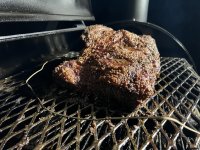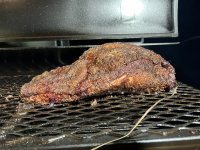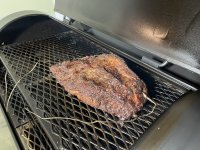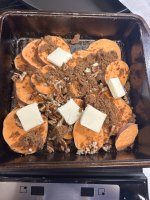Bumping the thread as I've run into another question- this one specific to those who have experience using charcoal barrel smokers like the Weber Smokey Mountain that I have. Here's a quick stock photo for reference...
View attachment 8730912
So onto my question- for those unfamiliar with this particular model, it has 3 dampers at the bottom (and one on the lid) used to control airflow/temperature. The 'quirk' I'm finding though is that the grate which the coals sit on is actually placed low enough that it dissects the area where the damper is. The issue this is causing me is when I'm doing larger cuts of meat/longer smokes I'm going through a lot of charcoal and the ash that accumulates beneath the grate actually rises to the point where the bottom two holes of that damper (so 6 holes total) actually end up being "clogged" and out of commission due to this ash.
As an example, I just finished a ~10 lb pork butt which took a bit under 20 hours with going 225º the first 12-13 hours & bumping it up to 250-275º for the last part (trying to get it done to time) and that amounted to around 30lbs of Kingsford charcoal. Had I used Royal Oak charcoal, I'd imagine that I would have used as much if not more since it seems to burn hotter & faster than the Kingsford. When I screw with the dampers and see a chunk if not most of the holes covered by ash I'd have to pressure this is reducing my abilities to control the O2 coming in and thusly my ability to control temperature at the end of my smokes.
So the TL/DR- for long smokes using a charcoal barrel smoker, what's the "trick" (or any tips) on controlling the ash buildup to prevent this? I thought about getting something like a wet/dry vac to suck up the ash when it's getting to a certain height but as many here will know- that ash isn't necessarily cold, especially in the middle of a smoke and I have to believe sucking it into a wet/dry vac is a surefire way to either (a) ruin it (b) cause a fire or (c) both. But I'm completely at a loss of how to handle this particular issue.
I've got a few smokes under my belt since I started this thread- a number of Boston Butts, ribs, hams & chickens and I'd like to tackle a big ol' brisket this summer but I'm already nipping at the heels of the limits with the ash build up and the brisket will likely take even longer than the pork butt and I don't know how to stay on top of the ash and don't want to find myself with smothered coals, unusable dampers, and a $100+ slab of brisket that isn't fully cooked with an audience waiting for me to know how to 'fix' it.
Any thoughts/tips on this rather... specific situation?
-LD
Definitely not a pit master and my smoker is very different from yours.
Still a couple things I'll toss out there. Early in longer cooks I'll use dry firewood to supplement the charcoal. Usually wild cherry but sometimes apple or Birch. Second, I find kingsford ok for grilling, but I'm not fond of the smoke.








